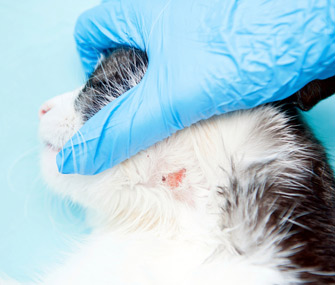Ringworm in Dogs, Cats and Humans: The Gift That Keeps on Giving
Published on December 11, 2013

But I take heart in knowing I’m not alone. One of my technicians has ringworm lesions on her upper lip, forehead, and the nape of her neck. This travesty, along with a constellation of blemishes cascading down her arms, confirms that we must’ve been frolicking with the same patients (most likely those adorable scraggly kittens we couldn’t keep our hands off).
As if this ringworm-sharing adventure wasn’t already bad enough, just yesterday I happened upon the worst of it: My 11-month-old Malinois, Violet, is sporting a suspect spot between the toes of her left front foot. This, along with a can’t-be-anything-but-ringworm splotch on her upper lip (yes, the very lip she likes to nuzzle us with), confirms my suspicions. Sigh.
Is It a Worm?
By now you’re either feeling very sorry for me (and well you should) or you’re just plain confused. Isn’t ringworm a worm? Why would it attack your face?
OK, so for those of you understandably perplexed by the veterinary misnomer that is “ringworm,” let me explain.
In spite of its unappetizing and highly misleading nomenclature, ringworm is not caused by worms. Rather, a fungus is to blame. The term ringworm results from the characteristically ringlike lesions observed on the skin of its hapless victims. And it’s most often brought to you by a fungus known as Microsporum canis. (Although two other species of fungus can also cause ringworm infections, they do so less often.)
Scientifically speaking, all of these ringworm-y fungi are referred to as dermatophytes. Which is why the disease state they trigger is referred to as dermatophytosis. And, as you might’ve guessed by now, the dermatophytes that cause ringworm are not only contagious between animals, they’re zoonotic too (which means they’re transmissible between humans and animals).
The Unflattering Effects
Here’s how they work: The dermatophytes that cause ringworm are microscopic organisms that invade the superficial layers of the skin, hair or claws. Because fungi thrive in moist environments, they’re especially persistent in humid climates and damp surroundings (like Miami, where I live). Which means that my Violet could’ve just as easily caught it from me as from the moist soil she loves to root around in.
In pets, ringworm causes the hair to become brittle and break, leaving behind ugly patches of hairless skin (especially around the face, ears, limbs and toes). Within these hairless patches, the skin typically gets crusty or inflamed, especially around the edges. So much so that the lesions typically take on a pinkish hue with rosy edges and an adjacent crusty border (hence the ringlike appearance).
While the fungal infection itself isn’t considered itchy, the secondary bacterial infections that ensue whenever inflammation undermines the skin’s normal defensive barriers are. Sometimes unbearably itchy, if my own lesions are any guide.
But here’s the thing: Not all dermatophytes follow the same rules of invasion. Not only will some fail to elicit the tiny crop circles we’ve come to expect, the truth is that some animals won’t show any signs of dermatophytosis — at all.
Instead, these “lucky” few may serve as carriers of infection, shedding fungal spores into the environment and functioning as a reservoir for infection should any unfortunate pet or human sidle up to them too cozily — sometimes for months! Which makes the whole ringworm thing that much more annoying and insidious.
Fortunately, identifying ringworm infections in an animal typically isn’t too tough to do. Even if the diagnosis isn’t immediately made plain by its ringlike appearance, a test called a fungal culture is easily enough undertaken. Unfortunately, fungal growth isn’t instantaneous, which is why results may not be available for two weeks or more. It’s also why plenty of veterinarians employ an ultraviolet light to help sort things out. In most cases (but not all), the offending organisms will glow a bright apple green.
To Treat or Not to Treat?
You’d think these creatures, as tenacious and ubiquitous as they are, would be hard to treat. But here’s the reality: Most infections are self-limiting; which means that in healthy animals (and humans), they usually go away all by themselves. Unfortunately, it can take as long as three months for the lesions to recede, which is why so many of my clients elect to treat — ASAP!
Dips, shampoos, creams, ointments, unguents and salves… they’ll help. In tough cases, so might some higher-octane treatments (typically in the form of oral medications) or perhaps even a trip to a veterinary dermatologist.
So what’s in store for me and mine?
Thus far, we’ve been lucky enough to count the sum total of our lesions on the fingers of a single hand. Though it doesn’t seem so slight a grievance when the urge to itch it overcomes me (or when Violet threatens to rub her face along the length of my arm), I know we’ve got it easy compared to others. After all, if the biggest hardship I have to face is to play host to an insufferable bunch of unsightly spores, I’ll be the first to celebrate.





